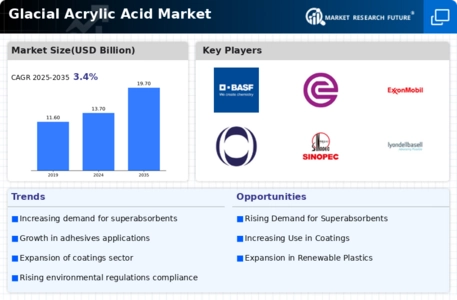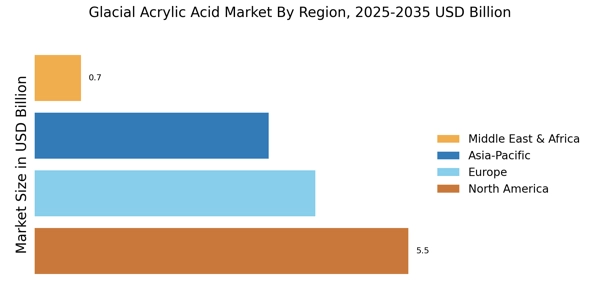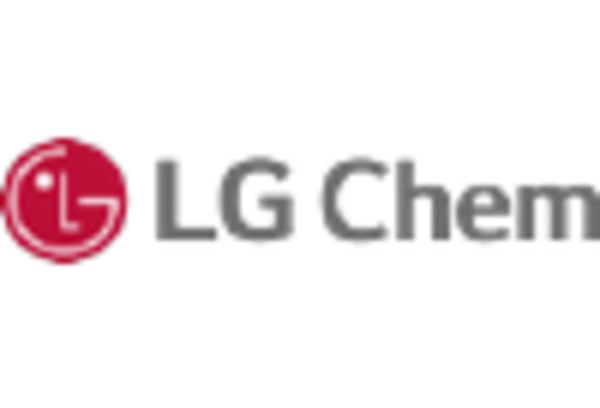Growth in Coatings and Adhesives Sector
The coatings and adhesives sector is a pivotal driver for the Glacial Acrylic Acid Market, as glacial acrylic acid serves as a key raw material in the formulation of various coatings and adhesives. The increasing demand for high-performance coatings in automotive, construction, and industrial applications is expected to fuel market growth. According to recent data, the coatings segment is anticipated to witness a CAGR of around 4.8% in the coming years. This growth is attributed to the rising need for durable and environmentally friendly products, which glacial acrylic acid can provide. As manufacturers continue to innovate and develop advanced formulations, the reliance on glacial acrylic acid is likely to expand, thereby enhancing its market presence.
Increasing Focus on Renewable Resources
The Glacial Acrylic Acid Market is witnessing a shift towards renewable resources, as manufacturers and consumers alike become more environmentally conscious. The development of bio-based acrylic acid from renewable feedstocks is gaining traction, which could potentially reshape the market landscape. This trend aligns with global sustainability initiatives aimed at reducing reliance on fossil fuels. Market data indicates that the bio-based acrylic acid segment is expected to grow significantly, with projections suggesting a CAGR of around 6% over the next few years. As companies invest in research and development to create sustainable alternatives, the demand for glacial acrylic acid derived from renewable sources may increase, thereby influencing market dynamics.
Rising Demand in Superabsorbent Polymers
The Glacial Acrylic Acid Market is experiencing a notable surge in demand for superabsorbent polymers (SAPs), which are extensively utilized in personal care products, such as diapers and feminine hygiene items. This demand is driven by an increasing global population and a growing awareness of hygiene and comfort. SAPs, derived from glacial acrylic acid, are favored for their high absorbency and efficiency. Market data indicates that the SAP segment is projected to grow at a compound annual growth rate (CAGR) of approximately 5.5% over the next few years, thereby bolstering the glacial acrylic acid market. As manufacturers seek to innovate and enhance product performance, the reliance on glacial acrylic acid is likely to intensify, further propelling the market forward.
Expanding Applications in the Textile Industry
The textile industry is increasingly adopting glacial acrylic acid due to its versatility and effectiveness in various applications, including textile coatings and finishes. The Glacial Acrylic Acid Market is benefiting from this trend, as manufacturers seek to enhance the performance and durability of textiles. The demand for functional textiles, which offer properties such as water resistance and stain repellency, is on the rise. Market analysis suggests that the textile segment is projected to grow at a CAGR of approximately 4.2% in the near future. This growth is likely to be driven by consumer preferences for high-quality, durable fabrics, which in turn will bolster the demand for glacial acrylic acid as a critical component in textile processing.
Technological Innovations in Production Processes
Technological advancements in the production processes of glacial acrylic acid are playing a crucial role in shaping the Glacial Acrylic Acid Market. Innovations such as improved catalytic processes and energy-efficient methods are enhancing production efficiency and reducing costs. These advancements not only contribute to higher yields but also minimize environmental impact, aligning with the growing emphasis on sustainability. Recent data suggests that companies adopting these technologies may experience a reduction in production costs by up to 15%, thereby increasing competitiveness in the market. As the industry continues to evolve, the integration of cutting-edge technologies is likely to drive the demand for glacial acrylic acid, fostering growth within the market.


















Leave a Comment